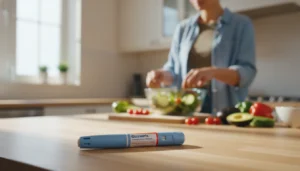Ozempic and Mealtimes: The Truth About Taking Your Medication

A common question echoes in the minds of many individuals embarking on a weight loss journey: do I take Ozempic on an empty stomach? This query highlights a natural concern about optimizing medication effectiveness and minimizing potential side effects. The precise timing of medication around meals can indeed be critical for many drugs, influencing their absorption and how they interact with the body. Understanding these nuances is a vital step toward a successful and comfortable experience with any treatment.
At TrimRx, our journey began with a shared vision to help individuals embrace healthier lifestyles by merging cutting-edge telehealth innovations with effective weight loss solutions. We understand that navigating new prescriptions and lifestyle changes can feel overwhelming. That’s why our platform is a user-friendly and supportive space where individuals receive personalized, medically supervised care—all designed to make sustainable weight loss attainable and tailored to the individual. We believe that sustainable weight loss should be achieved through science, empathy, and a transparent approach.
This comprehensive guide will delve into the specifics of Ozempic administration, clarifying whether you need to take it on an empty stomach, exploring how it works, and offering invaluable insights into dietary considerations and best practices for managing your treatment. We will provide a detailed look at the factors that truly impact your weight loss journey, moving beyond simple timing to encompass a holistic approach. By the end of this post, you will have a clear understanding of how to maximize the benefits of your medication and cultivate lasting healthy habits, supported by evidence-based information and our commitment to your well-being.
Understanding Ozempic: How It Works for Weight Management
To truly grasp the answer to “do I take Ozempic on an empty stomach,” it’s essential to first understand how this medication functions within the body. Ozempic, a brand name for the active ingredient semaglutide, belongs to a class of drugs known as GLP-1 receptor agonists. These medications mimic the action of a natural hormone called glucagon-like peptide-1 (GLP-1), which plays a crucial role in regulating blood sugar and appetite.
The Science Behind Semaglutide
When we eat, our bodies naturally release GLP-1. Semaglutide, by acting like this hormone, triggers several beneficial physiological responses:
- Insulin Release: It stimulates the pancreas to release insulin when blood sugar levels are high. Insulin is vital for helping the body’s cells absorb glucose from the bloodstream, using it for energy or storing it. For individuals managing Type 2 diabetes, this action helps lower blood sugar.
- Glucagon Suppression: Semaglutide also decreases the secretion of glucagon, another hormone that signals the liver to release stored glucose. By reducing glucagon, it helps prevent excessive sugar production, further contributing to blood sugar control.
- Slowed Gastric Emptying: One of the most significant mechanisms for weight management is the slowing of gastric emptying. This means food stays in the stomach for a longer period, contributing to a prolonged feeling of fullness and satiety after meals. This effect naturally helps reduce overall food intake.
- Appetite Reduction: By promoting a feeling of fullness and influencing hunger signals in the brain, semaglutide helps to reduce appetite and cravings, making it easier to adhere to a reduced-calorie diet.
These combined effects make medications like Ozempic powerful tools in both blood sugar management for Type 2 diabetes and, at specific dosages (as seen with Wegovy, which is also semaglutide, or Zepbound/Mounjaro which use tirzepatide), in chronic weight management. Our commitment at TrimRx is to offer a range of these clinically proven solutions, including [Compounded Semaglutide], [Oral Semaglutide], [Ozempic®], [Compounded Tirzepatide], [Oral Tirzepatide], [Mounjaro®], [Zepbound®], and [Wegovy®], always provided through FDA-registered, inspected, and approved pharmacies, ensuring the highest standards of safety and quality.
Ozempic is an Injectable Medication
The key to answering the question “do I take Ozempic on an empty stomach” lies in its method of administration. Ozempic is an injectable medication. This means it is delivered directly into the subcutaneous tissue (under the skin) rather than being swallowed as a pill. Because it bypasses the digestive system entirely, the presence or absence of food in your stomach at the time of injection has no impact on how the medication is absorbed or how effectively it works.
This fundamental difference from oral medications, which interact with stomach acids and digestive enzymes, provides a great deal of flexibility. Therefore, the simple and reassuring answer is: Ozempic can be taken with or without food.
Administering Ozempic: What You Need to Know
While the timing relative to meals isn’t a concern, proper administration and adherence to your treatment plan are paramount for safety and effectiveness. Our goal at TrimRx is to make this process as clear and straightforward as possible, empowering you to manage your medication confidently.
Injection Timing and Consistency
The most important aspect of Ozempic administration is consistency. Ozempic is a once-weekly injection. This means:
- Pick a Day: Choose a specific day of the week that works best for your schedule (e.g., every Monday morning).
- Stick to the Time: Try to inject your dose around the same time on your chosen day each week. This helps maintain steady levels of the medication in your system.
- Flexibility When Needed: If you need to change your injection day, you can do so as long as there are at least two days between doses. For instance, if you usually inject on Monday but want to switch to Friday, you can take your next dose on Friday, provided at least 48 hours have passed since your last Monday dose.
This consistency is vital for the medication to work optimally over the course of the week, helping to regulate your appetite and blood sugar effectively.
Proper Injection Technique and Sites
Correct injection technique is crucial for safe and effective delivery of Ozempic. Our programs include comprehensive guidance on this, ensuring you feel confident with each dose.
Where to Inject
Ozempic is administered as a subcutaneous injection, meaning into the fatty tissue just under the skin. The preferred areas for injection are:
- Abdomen: The area around your belly button, at least 2 inches away from the navel. This offers ample subcutaneous fat.
- Thigh: The front and sides of your upper thighs.
- Upper Arm: The soft area on the back or underneath the upper arm, between the elbow and shoulder.
Rotating Injection Sites
It’s important to rotate your injection site each week. This means if you inject into your abdomen one week, you might choose your thigh the next week, or a different spot within the same general area. For example, if you inject into the upper left abdomen one week, you might use the upper right abdomen the next.
Why rotate? Rotating sites helps prevent:
- Skin irritation, redness, or tenderness.
- Lumps or hardened areas under the skin.
- Changes in fat distribution, which can affect absorption over time.
General Injection Steps (Simplified)
While detailed instructions come with your medication, here’s a general overview:
- Preparation: Wash your hands. Check your pen to ensure it’s the correct medication and the liquid is clear.
- Attach Needle: Always use a new needle for each injection. Push and twist it on firmly. Remove the outer and inner needle caps.
- Check Flow (New Pen Only): For a new pen, perform a flow check to ensure a drop of medication appears at the needle tip.
- Select Dose: Turn the dose selector to your prescribed dose.
- Clean Site: Wipe the chosen injection site with an alcohol swab and let it dry completely.
- Inject: Insert the needle fully into the skin. Press and hold the dose button until the dose counter returns to 0. Slowly count to six before withdrawing the needle to ensure the full dose is delivered.
- Dispose: Carefully remove the needle and immediately dispose of it in an FDA-approved sharps container or a sturdy plastic container. Never recap used needles.
Our commitment to safety means we partner with FDA-registered and inspected pharmacies for the shipping of all weight loss medications. We provide clear guidance and support to help you follow these important steps.
What to Do if You Miss a Dose
Life happens, and sometimes a dose might be missed. If you forget to take your Ozempic dose:
- Take it as soon as you remember, if it’s within five days (120 hours) of your regularly scheduled dose.
- If it has been longer than five days, skip the missed dose and take your next dose on your regularly scheduled day and time.
- Never take a double dose to make up for a missed one.
If you have any questions or concerns about a missed dose, our unlimited support is always available to guide you.
Beyond the Injection: Optimizing Your Weight Loss Journey with Diet and Lifestyle
While the answer to “do I take Ozempic on an empty stomach” is straightforward (it doesn’t matter for absorption), the food you choose to eat—and when you eat it—plays a profound role in how you feel and your overall success on a GLP-1 medication. Ozempic is designed to work with a healthy lifestyle, not as a standalone solution. At TrimRx, we emphasize that sustainable weight loss requires a comprehensive approach.
Dietary Adjustments for Maximum Effectiveness
Ozempic and similar medications primarily work by reducing appetite and increasing satiety. This provides a unique opportunity to cultivate new, healthier eating habits.
Focus on Nutrient-Dense Foods
Embrace a diet rich in whole, unprocessed foods that provide essential nutrients without excessive calories. This includes:
- Lean Proteins: Chicken, turkey, fish, eggs, beans, lentils, tofu. Protein helps you feel full and supports muscle mass during weight loss.
- Fruits and Vegetables: A wide variety of colorful produce provides vitamins, minerals, and fiber. Fiber is particularly important as it adds bulk and aids digestion, which can be beneficial with slowed gastric emptying.
- Whole Grains: Oats, brown rice, quinoa, whole-wheat bread. These complex carbohydrates offer sustained energy and fiber.
- Healthy Fats: Avocados, nuts, seeds, olive oil. These are crucial for overall health and can contribute to satiety in moderate amounts.
Our personalized weight loss programs often include guidance from dieticians to help you build these lasting habits, ensuring you receive the nourishment your body needs. To see how our programs can support you, we encourage you to [take our free assessment quiz].
Mindful Portion Control
Because Ozempic makes you feel fuller faster and for longer, you’ll likely find that smaller portions are satisfying. Eating large meals, even if they consist of healthy foods, can lead to discomfort, nausea, or a feeling of being overly full, especially as your digestive system adjusts to the slowed emptying.
- Listen to Your Body: Pay attention to your hunger and fullness cues. Stop eating when you feel comfortably satisfied, not stuffed.
- Smaller Plates: Using smaller plates can visually help with portion control.
- Eat Slowly: Savor your meals. Eating slowly gives your body time to register fullness signals.
Hydration is Key
Drinking plenty of water throughout the day is always important, but it becomes even more crucial when taking GLP-1 medications. Adequate hydration supports digestion, can help mitigate some side effects, and contributes to a feeling of fullness.
- Water First: Make water your primary beverage choice.
- Small Sips: If you experience nausea, sipping small amounts of water or clear broths throughout the day can be more tolerable than drinking large quantities at once.
Foods to Limit or Avoid to Minimize Side Effects
While there are no universally “forbidden” foods, certain dietary choices can exacerbate common gastrointestinal side effects associated with Ozempic.
- High-Fat and Greasy Foods: Foods like fried items, fast food, and very rich sauces can be difficult to digest when gastric emptying is slowed. They can worsen nausea, bloating, and indigestion.
- Sugary Foods and Drinks: Excessive sugar, especially from sweetened beverages, candies, and highly processed desserts, can contribute to blood sugar spikes and offer little nutritional value.
- Processed Foods: Often high in unhealthy fats, sugar, and sodium, processed snacks and meals can contribute to discomfort and work against your weight loss goals.
- Large Portions: As mentioned, overeating can trigger nausea and stomach upset due to the delayed digestion.
- Alcohol: Alcohol can potentially interact with Ozempic, affecting blood sugar levels and increasing the risk of side effects like nausea and stomach upset. It’s often recommended to limit or avoid alcohol consumption.
By making conscious food choices, you can work in harmony with your medication to achieve better results and a more comfortable experience. Our personalized programs at TrimRx aim to empower you with this knowledge and support.
Managing Potential Side Effects with a Thoughtful Approach
One of our core values at TrimRx is providing compassionate care that respects every individual’s unique journey. We understand that while Ozempic is a powerful tool, like all medications, it can come with side effects. Most are mild to moderate and often subside as your body adjusts. Being prepared and knowing how to manage them can make a significant difference.
Common Gastrointestinal Side Effects and Management
Given how GLP-1 medications work, digestive issues are the most frequently reported side effects.
- Nausea: This is a common initial side effect.
- Management: Eat smaller, more frequent meals. Avoid greasy, spicy, and very sweet foods. Sip clear liquids. Try ginger-containing foods or beverages. Taking your injection at a time of day when you can rest afterwards might also help some individuals.
- Vomiting: Can occur, often alongside nausea.
- Management: Similar to nausea. Focus on bland foods (toast, crackers, rice). Stay hydrated with small sips of water or electrolyte solutions.
- Diarrhea:
- Management: Stay well-hydrated. Opt for lower-fiber foods temporarily (e.g., white rice, bananas) to help firm stools. Avoid very fatty or spicy foods.
- Constipation: Can occur due to slowed digestion.
- Management: Increase your fluid intake. Incorporate more fiber-rich foods (fruits, vegetables, whole grains), gradually. Regular physical activity can also help. Over-the-counter laxatives might be considered after discussing with an affiliated healthcare provider.
- Stomach Pain, Bloating, and Gas:
- Management: Eat slowly, avoid large meals, and limit high-fat foods. Over-the-counter remedies like simethicone may provide relief from gas.
Remember, our brand is empathetic and supportive. If side effects become bothersome or persistent, our unlimited support is there for you. It’s crucial to reach out to an affiliated healthcare provider to discuss your symptoms. They may suggest dose adjustments or other strategies.
Less Common but Serious Side Effects
While rare, it’s important to be aware of potentially serious side effects and know when to seek immediate medical attention. We are committed to your safety, which is why our approach emphasizes medically supervised care and working exclusively with FDA-registered and inspected pharmacies.
- Pancreatitis: Characterized by severe, persistent abdominal pain that may radiate to the back, often with vomiting.
- Thyroid C-cell Tumors: In animal studies, semaglutide caused thyroid tumors. It’s unknown if this occurs in humans. Discuss any personal or family history of thyroid cancer with an affiliated healthcare provider before starting. Report any lump in the neck, hoarseness, or trouble swallowing.
- Gallbladder Problems: Including gallstones, which can cause severe abdominal pain.
- Hypoglycemia (Low Blood Sugar): Especially if taking Ozempic with other diabetes medications like insulin or sulfonylureas. Symptoms include dizziness, shakiness, sweating, confusion.
- Severe Allergic Reactions (Angioedema): Swelling of the face, lips, tongue, or throat, difficulty breathing. Seek emergency care immediately.
- Gastroparesis: In rare instances, GLP-1 medications can severely slow stomach emptying, leading to a condition similar to gastroparesis. Symptoms include persistent nausea, vomiting of undigested food, and bloating.
Your safety and well-being are our highest priorities. Our comprehensive service includes doctor consultations and lab work to help ensure your treatment plan is appropriate and monitored effectively.
TrimRx: Your Partner in Sustainable Weight Loss
At TrimRx, we stand as your dedicated partner in achieving safe, effective, and sustainable weight loss. Our philosophy is rooted in combining advanced medical science with modern technology, delivered with empathetic and trustworthy care. Our personalized programs are designed not just for immediate results, but for creating lasting lifestyle changes that support your long-term health.
The TrimRx Difference: A Personalized Approach
We understand that every individual’s body and journey are unique. Our approach is never one-size-fits-all.
Step 1: Personalized Assessment
Your journey with us begins with a crucial first step: our [free assessment quiz]. This quick, confidential quiz helps us understand your health profile, medical history, and weight loss goals to determine your eligibility for our prescription weight loss medications. These include a range of options such as [Compounded Semaglutide], [Oral Semaglutide], [Ozempic®], [Compounded Tirzepatide], [Oral Tirzepatide], [Mounjaro®], [Zepbound®], and [Wegovy®].
Upon completion, an affiliated healthcare provider reviews your information to create a truly personalized treatment plan tailored to your specific needs. This meticulous process ensures that the prescribed medication and dosage are right for you, and helps address any questions you might have, including aspects like “do I take Ozempic on an empty stomach” or specific dietary guidance.
Step 2: Comprehensive Support, No Hidden Fees
Our commitment to transparent service means that our approach remains consistent, whether you’re starting on a lower dose or progressing to a higher one. When you enroll in a TrimRx personalized weight loss program, you receive a comprehensive package designed for success:
- Doctor Consultations: Regular virtual consultations with affiliated licensed medical providers who oversee your treatment, monitor your progress, and make any necessary adjustments.
- Prescription Medication: Access to clinically proven medications, sourced from FDA-registered, inspected, and approved pharmacies, and shipped directly to your door. It’s important to clarify that compounded medications are not FDA approved; however, branded medications like Ozempic®, Mounjaro®, Zepbound®, and Wegovy® are FDA approved for their respective indications.
- Lab Work: Necessary lab tests to ensure the safety and effectiveness of your treatment, providing a complete picture of your health.
- Unlimited Support: Ongoing access to our dedicated support team, ready to answer your questions and provide encouragement throughout your journey.
- Shipping: Convenient and discreet shipping of your medication directly to you.
We pride ourselves on offering this comprehensive service with no hidden fees, embodying our trustworthy and results-oriented brand personality.
Quick-Access Supplements for Immediate Wellness Support
While our prescription programs are personalized and require a qualification process, we also offer immediate support for your overall wellness journey through our quick-access supplements:
- [GLP-1 Daily Support]: Designed to complement your weight loss efforts, supporting healthy metabolism and gut function.
- [Weight Loss Boost]: Formulated to enhance your body’s natural ability to burn fat and boost energy levels.
These supplements are available for immediate purchase, providing additional tools to support your health goals while you explore our personalized programs or simply seek general wellness enhancement.
The Path Forward: Embracing a Healthier You
Embarking on a weight loss journey is a significant step, one that requires commitment, understanding, and the right support. While the question “do I take Ozempic on an empty stomach” might seem small, it opens the door to a broader conversation about how to truly maximize the benefits of your medication and cultivate a lifestyle that supports lasting health.
We’ve seen that for injectable medications like Ozempic, the timing relative to meals doesn’t impact absorption. However, what you eat, the portions you choose, and how you manage potential side effects are all critical components of a successful treatment plan. By focusing on nutrient-dense foods, practicing mindful eating, staying hydrated, and being aware of foods that might exacerbate discomfort, you can significantly enhance your experience and results.
At TrimRx, we are more than just a provider of medication; we are your empathetic and supportive partner in this transformative journey. We combine the power of advanced medical science with the convenience of telehealth, offering a personalized, medically supervised approach designed to make sustainable weight loss attainable. From your initial doctor consultation and necessary lab work, to receiving your medication from FDA-registered and inspected pharmacies, and benefiting from unlimited support, we are with you every step of the way.
We encourage you to take that vital first step toward a healthier, more vibrant future. Discover how our personalized programs can integrate seamlessly into your life and provide the comprehensive care you deserve. [Take our free assessment quiz] today to see if you qualify for our prescription weight loss solutions and start your personalized journey with TrimRx. For additional support, consider integrating our [GLP-1 Daily Support] or [Weight Loss Boost] supplements into your routine. Together, we can build a foundation for sustainable health and well-being.
Frequently Asked Questions
Q1: Is it really true that I can take Ozempic with or without food?
Yes, that is absolutely true. Ozempic is an injectable medication that is administered subcutaneously, meaning under the skin. Because it bypasses the digestive system and is not absorbed through the stomach, the presence or absence of food in your stomach at the time of injection does not affect how the medication is absorbed or its effectiveness. You have the flexibility to take your weekly dose at any time that is convenient for you.
Q2: If food doesn’t affect absorption, why is diet so important when taking Ozempic?
While food doesn’t impact Ozempic’s absorption, your dietary choices are crucial for maximizing its benefits and managing potential side effects. Ozempic works by making you feel fuller faster and longer, which reduces appetite. This effect is most beneficial when combined with a nutrient-dense, reduced-calorie diet. Eating high-fat, sugary, or large meals can exacerbate gastrointestinal side effects like nausea and bloating, making your journey less comfortable. A healthy diet supports overall well-being, helps prevent discomfort, and is essential for achieving sustainable weight loss alongside the medication. Our programs at TrimRx emphasize this holistic approach, often including dietary guidance from affiliated specialists.
Q3: What should I do if I experience nausea or other stomach upset after taking Ozempic?
Nausea and other gastrointestinal side effects are common, especially when starting Ozempic or increasing your dose, but they often improve over time. To manage them, try eating smaller, more frequent meals, avoiding greasy, spicy, and very sweet foods, and sipping on clear liquids. Foods containing ginger may also help with nausea. Ensure you stay well-hydrated. If side effects persist or are severe, it’s important to reach out to an affiliated healthcare provider. Our TrimRx programs offer unlimited support, allowing you to easily connect with professionals who can provide guidance and discuss potential adjustments to your treatment plan.
Q4: How does TrimRx ensure the safety and effectiveness of its weight loss medications?
At TrimRx, safety and effectiveness are paramount. We partner exclusively with FDA-registered and inspected pharmacies for the shipping of all our weight loss medications, including both branded products like Ozempic®, Mounjaro®, Zepbound®, and Wegovy® (which are FDA-approved for their respective indications), and compounded medications like Compounded Semaglutide and Compounded Tirzepatide (which are not FDA approved themselves, but are prepared in facilities regulated by the FDA). Our comprehensive service includes initial doctor consultations and ongoing medical supervision by affiliated licensed healthcare providers, along with necessary lab work, to ensure that each personalized treatment plan is safe, appropriate, and closely monitored. We are committed to transparent service and patient well-being every step of the way.

Transforming Lives, One Step at a Time
Keep reading
Navigating Your Treatment: How Many Pens in an Ozempic Box and What It Means for Your Health Journey
Curious how many pens in an Ozempic box? Our guide breaks down Ozempic pen strengths, doses, and how TrimRx supports your weight management journey. Click to learn more!
Empowering Your Health: A Comprehensive Guide on How to Use Ozempic Pens Effectively
Learn how to use Ozempic pens safely and effectively with our step-by-step guide. Master preparation, injection, & disposal for your weight management journey. Get expert tips!
Understanding Your Ozempic Pen: How to Tell When It’s Empty
Wondering how do I know when my Ozempic pen is empty? Learn key indicators, the dose counter trick, and proactive tips for consistent dosing.



